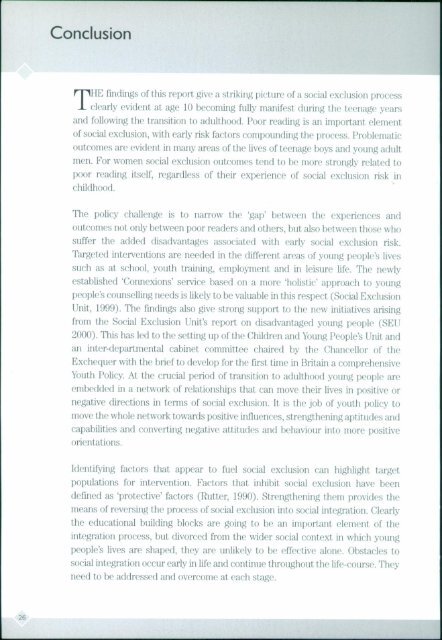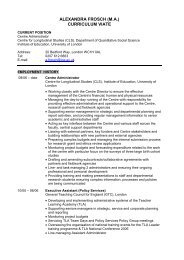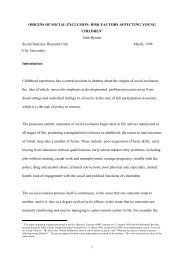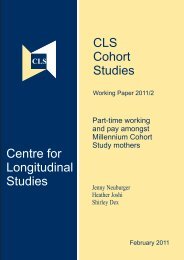Basic Skills and Social Exclusion - Centre for Longitudinal Studies
Basic Skills and Social Exclusion - Centre for Longitudinal Studies
Basic Skills and Social Exclusion - Centre for Longitudinal Studies
You also want an ePaper? Increase the reach of your titles
YUMPU automatically turns print PDFs into web optimized ePapers that Google loves.
ConclusionIiiii1iiit- iii IIHt lV1iitl LI\t' a -1riLili ,L ol social exclusion l)ro(T+1';I1,lY evident at age 10 becoming fully manifest during tit( , teenage ytII 01 l( )llowing the transition to adulthood. Poor reading is an important elemi it ii1 social exclusion, with early risk factors compounding the process. Problen iiit conies are evident in many areas of the lives of teenage boys <strong>and</strong> young iii IiFor women social exclusion outcomes tend to he more Strongly related Ior rcildifl o ilsilt, it'iitl]tss H! Iliit I '\l t(tieII(( HI ittiI isliisiii IHI\ isiildln itHis pull( . , ilstllsitgi IS it) IIaii(i\V Ilw gap lot \\tt11 the ;11 1,1till comes not only between poor readers <strong>and</strong> others, but also between those wIIfer the added disadvantages associated iNith early social exclusionT:irgeted interventions are needed in the different areas of young people's In1,110i as at school, youth training, employment <strong>and</strong> in leisure life. The m ie'"1 ablished 'Connexions' Service based on a more 'holistic' approach to yolill.I ples counselling needs is likely to be valuable in this respect (<strong>Social</strong> Exelimsit 'iiItiit, 1999). The findings also give strong support to the new initiatives ariskigii in the <strong>Social</strong> <strong>Exclusion</strong> Unit's report on disadvantaged young people (l I' iOU). This has le( I to I he setting up of the Children amid Young People's Unit i i, Iii inter-departmental cabinet coniniittee chaired by the Chancellor of Hit it ,I: \('hequer with the brief 1(1 develop <strong>for</strong> the first time iii Britain a ('omprehel isi1Oh Policy. At the crucial period of transition to adulthood young peoplell)ed(le(l in a network of relationships that can move their lives in posit iv(i gative directions in terms of social exclusion. It is t lie job of youth polic\iii ve the whole net work towards positive imilluences, strengthening aptitudes aitabilities arid liv rIioroativn ittiliiil's arid loliavinrin liii ionr pisiIIiisntitioii.ltlemitilvnig Hiltis liii ill ilili Ii lii1 siiial iS !iisiiiii (iiii Iiiiili!iiii nilations <strong>for</strong> intervention. Factors that inhibit social exclusion have hi iiI lined as 'protective' factors (Rutter, 1990). Strengthening them provides IF itiii 'ans of reversing the process of social exclusion into social integration. ClearlyI lit' educational building blocks are going to be an important element of iiin grat t ii process, but divorced front the wider social context iii which yoi iiple's lives are shaped, they are unlikely to be effective alone. ObstaclesSt ('ial integration occur early in life <strong>and</strong> continue tli niH! it I i i Ii Hi 'Iiioil Iii Ii ililr'ssssl irs) i,\trliiaI ;u}isIn.










